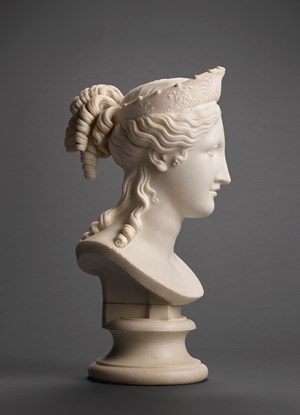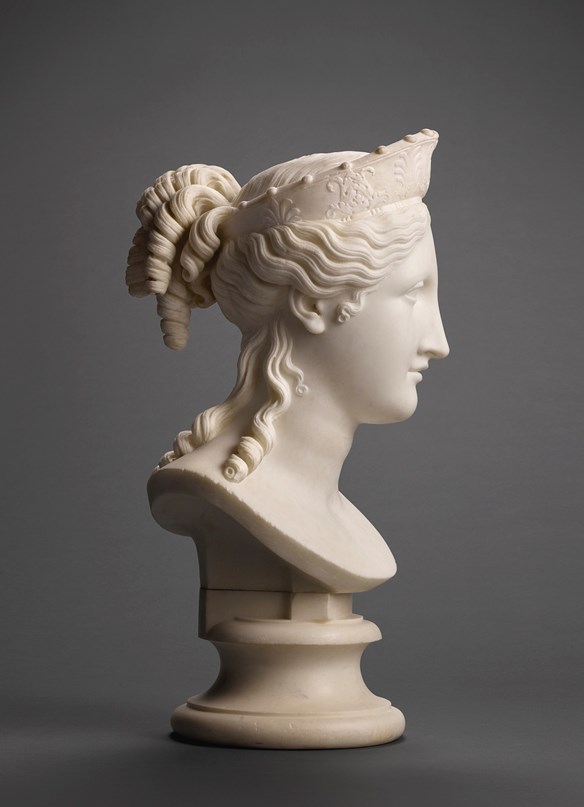
An original work by one of the greatest 19th century sculptors is at risk of being exported from the UK unless a buyer can be found to match the asking price of £5.3 million. The white marble ‘Bust of Peace’, made by Antonio Canova (1757-1822) has been blocked from export by Michael Ellis, Minister for Arts, Heritage and Tourism, to provide an opportunity to keep it in the country.
Image: ‘Bust of Peace’, Antonio Canova (1757-1822)
An original work by one of the greatest 19th century sculptors is at risk of being exported from the UK unless a buyer can be found to match the asking price of £5.3 million.
The white marble ‘Bust of Peace’, made by Antonio Canova (1757-1822) has been blocked from export by Michael Ellis, Minister for Arts, Heritage and Tourism, to provide an opportunity to keep it in the country.
The neo-classical bust, one of a handful of original works by the Italian neoclassical artist that remain outside museum collections, was sold to a private buyer at Sotheby’s in July 2018. Until then, it had been more than 200 years since it had last been seen in public.
 ‘Bust of Peace’, Antonio Canova (1757-1822)
‘Bust of Peace’, Antonio Canova (1757-1822)
The decision to defer the export licence follows a recommendation by the Reviewing Committee on the Export of Works of Art and Objects of Cultural Interest, administered by The Arts Council. They made their recommendation on the grounds that the sculpture is closely connected with the UK’s history and national life.
It can be seen to symbolise the return of peace to Europe after years of struggle and unrest during the Napoleonic era, which culminated in the Battle of Waterloo, where Napoleon was defeated.
Michael Ellis, Minister for Arts, Heritage and Tourism, said: "Canova is widely recognised as one of the greatest sculptors of his - or any - era.
The ‘Bust of Peace’ combines a crucial moment in our history with beauty and elegance, pointing to a more peaceful future ahead. Therefore it is essential that we do our best to save this superb item for the benefit of the nation".
The bust is one of Canova’s celebrated ‘Ideal Heads:’ female heads carved in marble, just under life size, representing a different conception of beauty and presented as gifts to friends and patrons who had helped him.
It was carved between 1814-15 and may have been given to John Campbell, Lord Cawdor, in part to thank him for his help in repatriating art looted from Italy by the French armies during the Napoleonic Wars. It was the first such bust to reach Britain, and the first to be presented to a British patron after Napoleon’s defeat. It was displayed at the Royal Academy Summer Exhibition in 1817.
Following Lord Cawdor’s death in 1821, the bust remained under the ownership of five generations of descendants in his family mansion of Stackpole Court in Pembrokeshire. However by the time the contents of the home were sold at auction in 1962, the bust’s significance had been lost. When it was sold, the head was simply described as “a white marble bust of a lady wearing a diadem,” without attribution.
The location and storage conditions were unclear for the following 50 years, until its re-emergence at an auction in 2012.
Reviewing Committee on the Export of Works of Art and Objects of Cultural Interest member Aidan Weston-Lewis said: "This outstanding bust was probably given by Canova as a token of friendship and gratitude to his most loyal British patron and champion, Lord Cawdor. Over nearly three decades, Cawdor commissioned several of Canova’s most celebrated works, including the reclining and standing versions of Cupid and Psyche, both now in the Louvre.
Due to political circumstances and periods of personal insolvency, he took possession of only a few, although among them was the Amorino now at Anglesey Abbey (National Trust), the first sculpture by Canova to come to Britain. As a testament to the special relationship between a brilliant and innovative British patron and statesman and the greatest artist of his day, every effort should be made to retain the Bust of Peace in the UK”.
Canova’s works are revered for his subtle artistry, sensitively working the surface of the marble, thereby giving his works a texture unparalleled by any of his contemporaries.

ArtDependence Magazine is an international magazine covering all spheres of contemporary art, as well as modern and classical art.
ArtDependence features the latest art news, highlighting interviews with today’s most influential artists, galleries, curators, collectors, fair directors and individuals at the axis of the arts.
The magazine also covers series of articles and reviews on critical art events, new publications and other foremost happenings in the art world.
If you would like to submit events or editorial content to ArtDependence Magazine, please feel free to reach the magazine via the contact page.